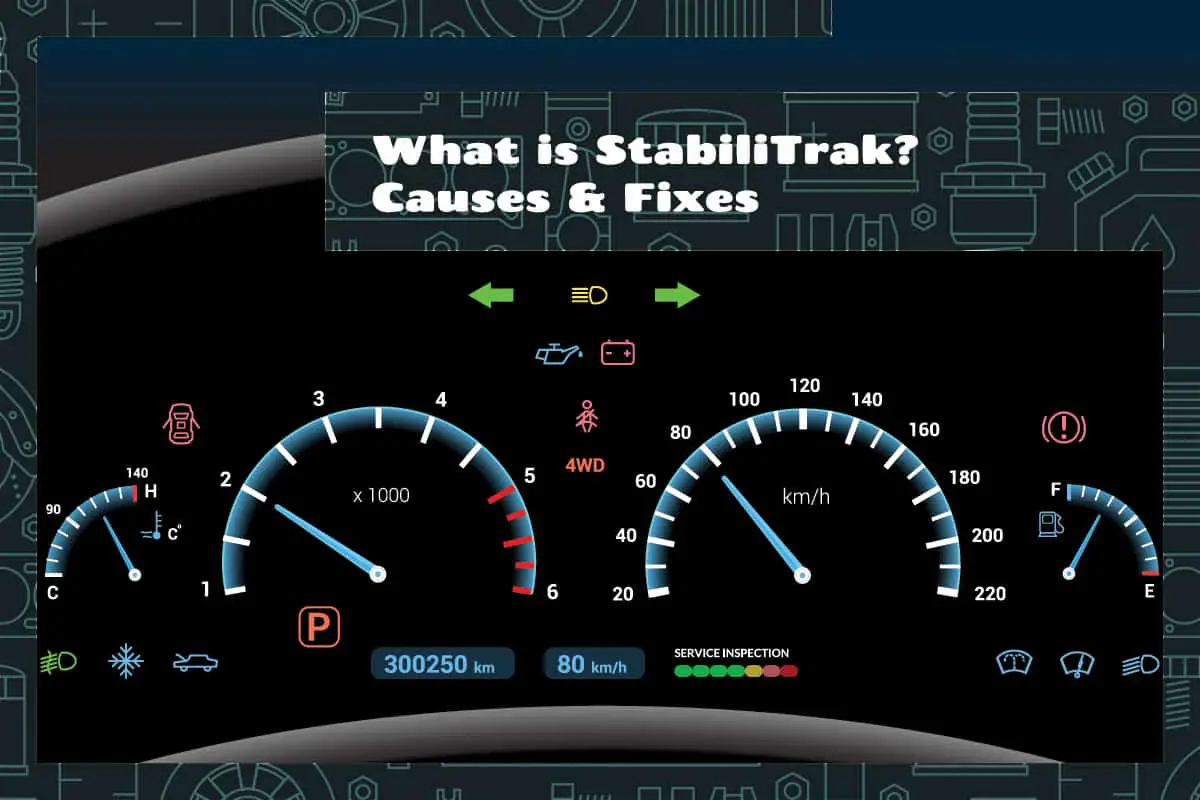StabiliTrak is a groundbreaking technology used in GM vehicles to enhance driving safety. It’s a computerized system that helps the driver maintain control of the car. As great as this technology is, it’s also prone to errors, which are indicated by warning messages on your dashboard.
StabiliTrak messages may appear due to sensor malfunctions, wiring issues, or mechanical problems. Addressing the issue usually involves a professional inspection, followed by repairs or replacements of the affected parts.
This article will go into the intricate details of StabiliTrak, exploring its mechanism, common causes of failure, and various fixes, both professional and DIY.
Basics of StabiliTrak
StabiliTrak is an advanced electronic stability control system that’s found in modern GM vehicles. It enhances the safety and control of a car by automatically detecting and correcting any potential loss of traction. If your vehicle starts to skid or slip, StabiliTrak takes over by adjusting the brakes and engine power to help you stay on your intended path.
The main goal of StabiliTrak is to enhance vehicle safety. Preventing loss of control can dramatically reduce the risk of accidents in various driving conditions, such as rain, snow, or sharp turns. It’s particularly helpful in unexpected situations, like turning sharply to avoid an obstacle.
How Does It Work?
To learn how this advanced piece of technology functions, we first need to learn about its various components.
Sensors are the eyes and ears of the StabiliTrak system. These include:
- Steering Angle Sensor: Measures the direction in which you intend to go.
- Wheel Speed Sensors: Determine how fast each wheel is spinning.
- Yaw Rate Sensor: Measures the vehicle’s side-to-side motion.
- Lateral Accelerometer: Detects sideways acceleration or sliding.
The control module is at the center of the StabiliTrak system. It takes data from various sensors and uses pre-set parameters to decide if the car is moving as intended. If not, it initiates corrective actions.
The StabiliTrak system applies specific corrections depending on the situation:
- Brake Application: If a wheel is spinning too fast, the system might apply the brake to that individual wheel.
- Engine Power Adjustment: If necessary, StabiliTrak can reduce engine power to prevent wheel spin.
- Steering Assistance: Some advanced systems can even provide subtle steering inputs to help the driver.
Common Causes of StabiliTrak Failure
StabiliTrak is a complex system that, unfortunately, can experience failures or malfunctions over time.
1. Sensor Malfunctions
Sensor issues can range from steering angle sensor failure due to wear and tear or exposure to extreme conditions, resulting in an incorrect reading of the steering wheel’s position.
Wheel speed sensors may fail due to accumulation of dirt or physical damage, causing misreading of individual wheel speeds.
Yaw rate sensor and lateral accelerometer failure may occur due to age, corrosion, or physical impact, leading to incorrect vehicle movement data.
2. Wiring and Electrical Issues
Damaged wiring from vibration, heat, moisture, or even rodents chewing through wires can disrupt the communication between sensors and controllers.
Fuse problems due to overload or short circuits can cause a loss of power to StabiliTrak components. Even a weak battery or a failing alternator can cause insufficient power for StabiliTrak operation.
3. Mechanical Problems
Mechanical problems, such as brake system malfunctions due to worn brake pads or leaky brake lines, can reduce the effectiveness of StabiliTrak’s braking interventions. Suspension and alignment issues from worn shocks, struts, or improper alignment can alter vehicle handling and reduce StabiliTrak’s effectiveness.
4. Software Glitches
Software glitches, including outdated or corrupted software or incompatibility with aftermarket parts, can cause incorrect functioning of StabiliTrak. These problems often require updating or reprogramming the software by a qualified technician.
5. Environmental Factors
Environmental factors, such as extreme weather conditions from exposure to intense heat, cold, or moisture, can cause malfunction of sensors or electrical components. Even road conditions, like potholes and uneven surfaces, can cause potential physical damage to sensors and alignment.
Symptoms of StabiliTrak Problems
You can usually tell when the StabiliTrak system is on the fritz by the following signs:
1. Warning Lights and Messages
These warnings are specifically designed to inform the driver that something is wrong with the StabiliTrak system. This might include a flashing “Service StabiliTrak” light or a “Traction Control Off” message.
2. Handling and Traction Issues
- Poor Traction in Wet or Slippery Conditions: If the system is malfunctioning, you might notice a loss of traction, especially in wet or icy conditions, making the vehicle more difficult to control.
- Vehicle Pulling to One Side: A problem with the StabiliTrak system might cause the vehicle to pull to one side during normal driving or while braking. This symptom might indicate an issue with the alignment or sensors that are part of the StabiliTrak system.
- Oversteering or Understeering: Oversteering is when the car turns more sharply than intended, while understeering is when it turns less sharply. Problems with StabiliTrak may lead to these symptoms as the system’s ability to control the vehicle’s movement is compromised.
3. Braking Issues
- Unusual Brake Behavior: StabiliTrak uses the vehicle’s brakes to help maintain control. If you notice that the brakes are engaging unexpectedly or failing to engage when needed, it could be a sign of a problem with the StabiliTrak system.
- ABS Warning Light: Since StabiliTrak works in conjunction with the Anti-lock Brake System (ABS), a problem with StabiliTrak may cause the ABS warning light to illuminate, indicating a potential issue with both systems.
Solutions for StabiliTrak Issues

There’s good news for you GM car owners out there: StabiliTrak issues are resolvable. The bad news is that these procedures may be too complex for the average person to manage alone.
Sensor Repair and Replacement
- Wheel speed sensors can be cleaned to remove dirt and debris. If the sensors are damaged or worn, replacement might be necessary.
- A defective steering angle sensor might require replacement, which typically involves removing the steering wheel and associated components.
After replacing sensors, calibration might be necessary to ensure accurate readings. This process usually requires specialized equipment and professional knowledge.
Electrical and Wiring Solutions
- Damaged or frayed wires can be repaired or replaced. Ensuring proper connections and insulation helps maintain the effectiveness of the StabiliTrak system.
- Blown fuses related to the StabiliTrak system can be replaced with new ones that match the specifications.
- Ensuring that the battery is in good condition and providing enough power is essential. A weak or failing battery might need replacement.
Mechanical Solutions
- Replacing worn brake pads, fixing leaky brake lines, or flushing and refilling brake fluid can restore the StabiliTrak’s braking interventions.
- Proper alignment and suspension repairs, including replacing worn shocks and struts, can enhance StabiliTrak’s control over the vehicle.
Software Solutions
- Outdated or corrupted software might require updating or reprogramming. This task usually requires specialized equipment and a trained technician.
- Incompatible aftermarket parts may cause issues with StabiliTrak. Removing or replacing them with compatible parts can resolve the problem.
FAQs
1. How can I identify StabiliTrak problems?
Identifying StabiliTrak problems is possible through a combination of observing symptoms and using diagnostic tools. Common signs include warning lights on the dashboard, such as a “Service StabiliTrak” or “Traction Control Off” message, handling and traction issues, unusual noises, or braking problems. For a precise diagnosis, you can use an OBD-II scanner to read error codes.
2. How much does professional repair usually cost?
The cost of professional repair for StabiliTrak issues can vary widely depending on the nature and extent of the problem. Simple fixes like cleaning or replacing a sensor might range from $50 to $200, while more complex repairs such as recalibrating sensors or updating software can cost upwards of $300 to $600. If the problem requires the replacement of major components or involves multiple issues, the price can even go over $1,000.






